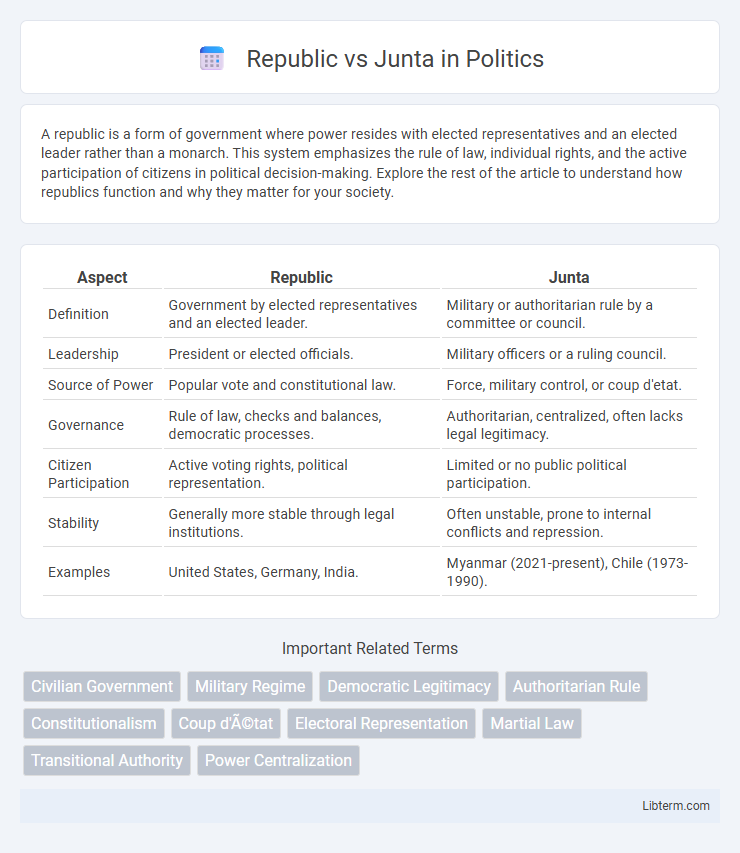A republic is a form of government where power resides with elected representatives and an elected leader rather than a monarch. This system emphasizes the rule of law, individual rights, and the active participation of citizens in political decision-making. Explore the rest of the article to understand how republics function and why they matter for your society.
Table of Comparison
| Aspect | Republic | Junta |
|---|---|---|
| Definition | Government by elected representatives and an elected leader. | Military or authoritarian rule by a committee or council. |
| Leadership | President or elected officials. | Military officers or a ruling council. |
| Source of Power | Popular vote and constitutional law. | Force, military control, or coup d'etat. |
| Governance | Rule of law, checks and balances, democratic processes. | Authoritarian, centralized, often lacks legal legitimacy. |
| Citizen Participation | Active voting rights, political representation. | Limited or no public political participation. |
| Stability | Generally more stable through legal institutions. | Often unstable, prone to internal conflicts and repression. |
| Examples | United States, Germany, India. | Myanmar (2021-present), Chile (1973-1990). |
Defining Republic and Junta
A republic is a form of government where power resides with elected representatives and officials, emphasizing rule of law, citizen participation, and constitutional frameworks. A junta typically refers to a military or political group that seizes power, often by force, and rules without democratic legitimacy or legal constraints. The key distinction lies in republics being founded on democratic elections and legal authority, whereas juntas maintain control through authoritarian imposition and centralized power.
Historical Origins of Republics
Republics trace their historical origins to ancient Rome, where power was held by elected representatives rather than a monarch, establishing a foundation for citizen participation in governance. The Roman Republic's model emphasized checks and balances through a complex system of assemblies and magistrates, contrasting sharply with the centralized rule typical of a junta. This early form of republicanism influenced the development of modern democratic states, promoting the rule of law and civic responsibility as core principles.
Historical Context of Military Juntas
Military juntas have historically emerged during periods of political instability and economic crises, particularly in Latin America and parts of Asia during the 20th century. These authoritarian regimes were often established following coups d'etat in countries such as Argentina, Chile, and Myanmar, where the military sought to consolidate power and suppress opposition. The transition from republics to military juntas typically involved the suspension of democratic institutions and civil liberties, resulting in centralized military control over government functions.
Political Structures: Republic vs Junta
A republic features a representative government where power is derived from the people through elected officials, emphasizing rule of law, constitutional frameworks, and separation of powers among branches. In contrast, a junta typically consists of a military or authoritarian group that seizes control, centralizing power without broad public participation or democratic legitimacy. The political structure of a junta often lacks institutional checks and balances, leading to governance based on command and control rather than legal-rational authority present in republics.
Key Features of Republican Governance
Republican governance emphasizes elected representation, rule of law, and separation of powers to ensure accountability and prevent autocracy. Key features include a constitution that enshrines citizens' rights, periodic free and fair elections, and an independent judiciary to uphold laws impartially. This system contrasts with a junta, where power is concentrated in military leaders without democratic legitimacy or institutional checks.
Characteristics of Junta Rule
Junta rule is characterized by military control, where power is concentrated in the hands of a few high-ranking officers who often suspend constitutional laws and civil liberties. Decision-making in a junta is typically autocratic, lacking transparency and political pluralism, with enforcement backed by armed forces. Unlike republics, where civilian institutions govern through elected representatives, juntas prioritize security and order over democratic processes and human rights.
Notable Examples of Republics
Notable examples of republics include the United States, established in 1776 with a constitution emphasizing democratic governance and rule of law, and the French Fifth Republic, founded in 1958 with a strong presidential system. The Federal Republic of Germany, formed in 1949, showcases parliamentary democracy with federalism, while India, since 1950, operates as the world's largest democratic republic based on secular and socialist principles. These republics contrast significantly with juntas, which are often military-led governments without democratic legitimacy.
Famous Military Juntas in History
Military juntas, such as the Chilean junta led by Augusto Pinochet (1973-1990), seized power through coups, overthrowing republics and ruling with authoritarian control. The Burmese military junta (1962-2011) maintained strict military dominance, suppressing democratic processes and civil liberties. Similarly, Argentina's military junta (1976-1983) was notorious for its brutal repression during the Dirty War, illustrating the contrast between republics' elected governance and juntas' undemocratic rule.
Impacts on Citizens and Society
Republic systems typically promote citizen participation, protection of individual rights, and legal accountability, fostering social stability and public trust. In contrast, juntas often impose authoritarian control, suppress dissent, and curtail freedoms, leading to societal unrest and human rights violations. These governance differences significantly influence economic development, social cohesion, and international relations.
Comparative Analysis: Republic vs Junta
A republic is a form of government where power is held by elected representatives and an elected leader, emphasizing rule of law, civilian authority, and institutional checks and balances. In contrast, a junta is typically a military or authoritarian regime where power is concentrated in the hands of a few military leaders who seize control, often bypassing legal frameworks and civilian governance. Republics prioritize democratic processes and citizen participation, whereas juntas rely on coercion, limited political freedoms, and centralized control.
Republic Infographic

 libterm.com
libterm.com